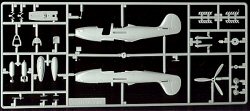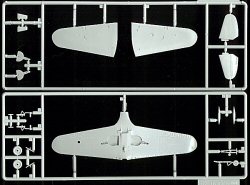Academy 1/72 Bell P-39N/Q Airacobra |  | History The P-39 began development in 1938 and was one of the first combat aircraft to feature tricycle landing gear, though the P-38 would beat the P-39 into production. Designed as a gunfighter, the P-39 was the subject of political manipulation during its development which precluded the use of a supercharger on the Allison engine. The result was a fighter that had poor performance above 10,000 feet. Nevertheless, the P-39 entered production and would become a deadly part of the allied arsenal. In US service, the P-39 would serve as the low-level component of air defense as it could hold its own against the Japanese fighters below 10,000 feet, with the Mustang/Thunderbolt covering the medium altitudes and the P-38 Lightning riding topcover. In Soviet service, the P-39 was not acknowledged in post-war histories until the late 1980s. The Airacobra was an integral part of tactical air forces providing close air support and interdiction missions against German forces. In capable hands, the P-39 also scored numerous air-to-air victories as long as the 3,000 meter (10,000 foot) rule was observed. The Kit This Academy kit is a re-release of their P-39N/Q kit (Nr 2177) that was released under the Academy and Academy/Minicraft logos. Molded in light grey styrene, the Academy kit features nicely scribed details and a variety of details from which to equip your Airacobra. The leftside cockpit door is molded as a separate piece, allowing this to be positioned open to show off the interior. The fuselage/wing fit is reported to be snug with no filler required. One interesting option in this kit - the 12-stack exhausts are included for the P-400 and/or P-39F, neither of which have been released from Academy (yet). Other details include integral wing guns of the P-39N or underwing gunpods of the P-39Q, a centerline external fuel tank or a bomb to be carried on the centerline. Markings are provided for three aircraft: -
P-39N, 29004, 9th Guards Aviation Regt as flown by Colonel A.I. Pokryshkin -
P-39Q, 42547, 16 Guards Aviation Regt as flown by Captain G.A. Rechkalov -
P-39N, 9th Guards Aviation Regt as flown by Major Sultan Amet-Khan Note: I am reminded by our own Matt Bittner that the blue backgrounds in the stars above are incorrect (a common mistake) as the Soviets used whatever green paint available to paint out the US or British roundels and then paint their own national markings over the top. Conclusions It is great to see this kit available again on store shelves and the Soviet Air Force markings are an interesting focus for this release. This kit is recommended! My sincere thanks to MRC for this review sample! | 









|













